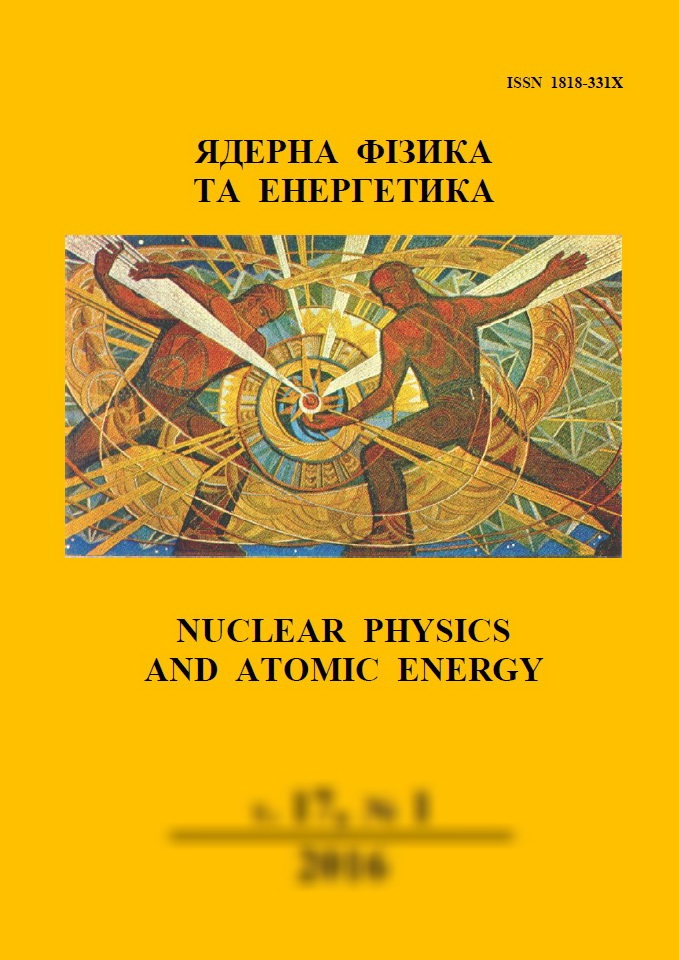 |
ßäåðíà ô³çèêà òà åíåðãåòèêà
Nuclear Physics and Atomic Energy
ISSN:
1818-331X (Print), 2074-0565 (Online)
Publisher:
Institute for Nuclear Research of the National Academy of Sciences of Ukraine
Languages:
Ukrainian, English, Russian
Periodicity:
4 times per year
Open access peer reviewed journal
|
Nucl. Phys. At. Energy 2015, volume 16, issue 1, pages 47-55.
Section: Radiation Physics.
Received: 15.12.2014; Accepted: 19.03.2015; Published online: 20.04.2015.
 Full Text (ua)
Full Text (ua)
https://doi.org/10.15407/jnpae2015.01.047
Effect of interaction between electronic excitations on luminescence from fast charged particle’s track’s region
I. Yu. Goliney*, V. I. Sugakov, A. A. Chernyuk
Institute for Nuclear Research, National Academy of Sciences of Ukraine, Kyiv, Ukraine
*Corresponding author. E-mail address:
goliney@kinr.kiev.ua.
Abstract:
The paper studies the effect of the interaction between the electronic excitations (excitons) on the light emission yield of the high energy charged particle in the dielectric medium. It is assumed that after being created in the track, the excitons diffuse from its core. Exciton annihilation and the non-radiative part of its lifetime contribute to the losses that manifest themselves as the decrease of the luminescence intensity. The dependence of the losses on the direction of propagation of the high energy charged particle with respect to the crystal axes for crystals with the exciton diffusion anisotropy is calculated. Dynamic interaction between excitons leads to the changes of their motion, affects the inter-exciton distance, and, hence, causes losses due to annihilation. The estimates of the losses are made depending on the interaction: an increase for the exciton attraction, a decrease for the repulsion. The possibility of the exciton condensation in the track region in the inorganic semiconductors is evaluated.
Keywords:
track, high energy particles, exciton, luminescence, anisotropy.
References:
1. N.Z. Galunov, O.A. Tarasenko. Formation of the ionizing radiation tracks in organic condensed media (Kharkov: ISMA, 2011) 480 p. (Rus)
Book
2. A.M. Miterev. Theoretical aspects of the formation and evolution of charged particle tracks. Sov. Usp. 45 (2002) 1019. (Rus)
http://doi.org/10.1070/PU2002v045n10ABEH001201
3. I.M. Livshi, M.I. Kaganov, L.V. Tanatarov. Atomnaya energiya 6 (1959) 391. (Rus)
4. V.S. Vavilov. Radiation effect on semiconductors (Moskva: Fizmatgiz, 1963) 264 p. (Rus)
5. V.S. Vavilov, N.P. Kekelidze, L.S. Smirnov. Radiation effect on semiconductors (Moskva: Nauka, 1988) 190 p. (Rus)
6. D. Twerenbold. Cryogenic particle detectors. Reports on Progress in Physics 59(3) (1996) 349.
https://doi.org/10.1088/0034-4885/59/3/002
7. Cryogenic Particle Detection, ed. by C. Enss. Topics in Applied Physics, Vol. 99 (Springer, 2005) 507 p.
Google Books
8. A. Giuliani. Neutrino physics with low-temperature detectors. Journal of Low Temperature Physics 167 (2012) 991.
https://doi.org/10.1007/s10909-012-0576-9
9. L.V. Keldysh, A.N. Kozlov. Collective Properties of Excitons in Semiconductors. JETP 54(3) (1968) 521. (Rus)
http://www.jetp.ac.ru/cgi-bin/dn/e_027_03_0521.pdf
10. Electronic processes in organic molecular crystals. Transfer, capture, spin effects, ed. by E.A. Silinsh (Riga: Zinatne, 1992) 364 p. (Rus)
11. N.D. Zhevandrov. Optical anisotropy and energy migration in molecular crystals (Moskva: Nauka, 1987) 168 p. (Rus)
12. A.M.M. Schiavi. Study of laser produced plasmas by X-ray and proton radiography. PhD thesis, Imperial College of Science, Technology and Medicine (London, 2003) 182 p.
http://gaps.ing2.uniroma1.it/aschiavi/Pubblicazioni/PhD/ASchiavi_PhD.pdf
13. M.A. Spackman, P. Munshi, B. Dittrich. Dipole Moment Enhancement in Molecular Crystals from X-ray Diffraction Data. ChemPhysChem 8(14) (2007) 2051.
http://doi.org/10.1002/cphc.200700339
14. T. Rajs, Dzh. Khensel, T. Fillips, G. Tomas. Electron-hole liquid in semiconductors (Moskva: Mir, 1980) 352 p. (Rus)
